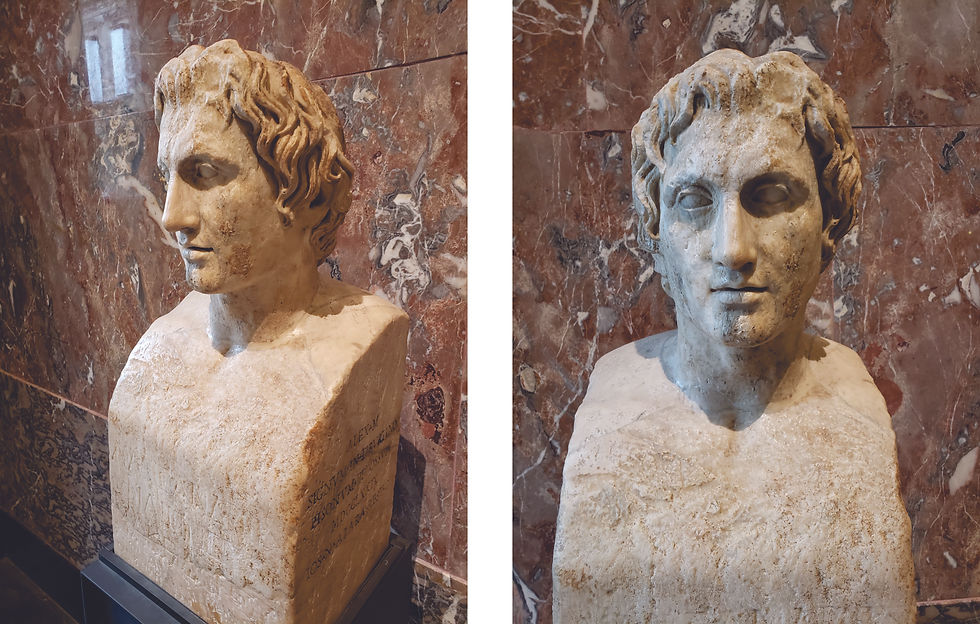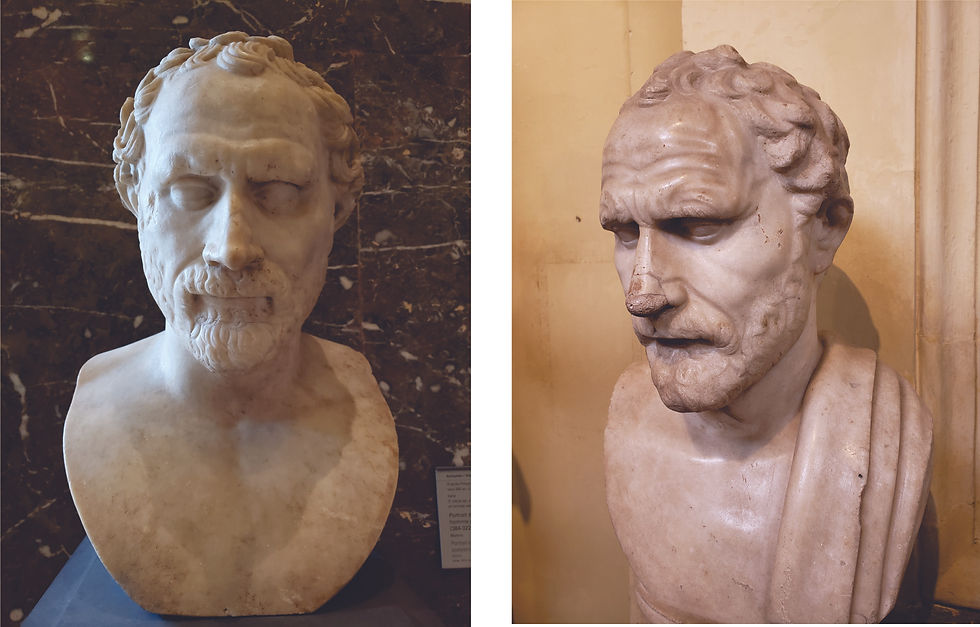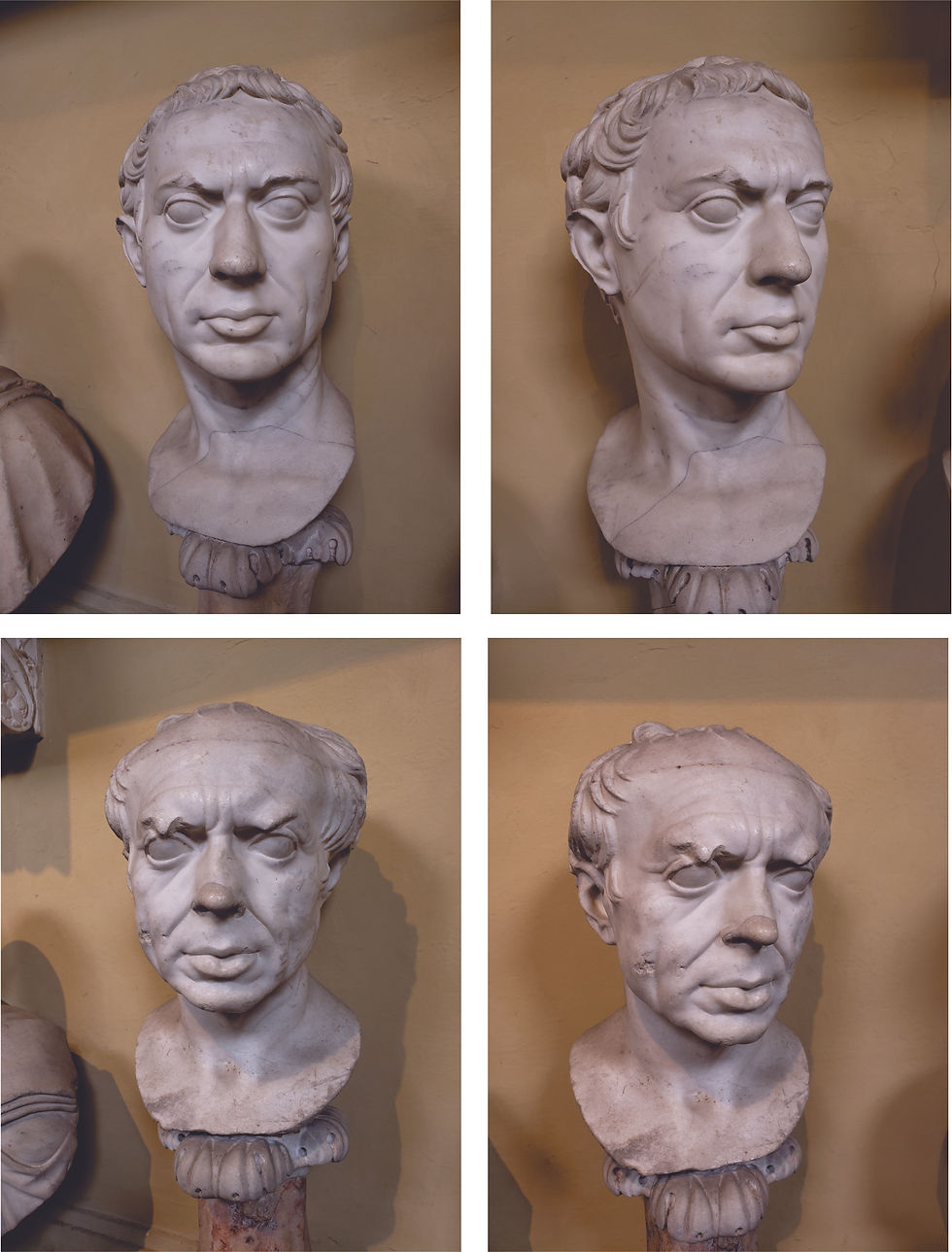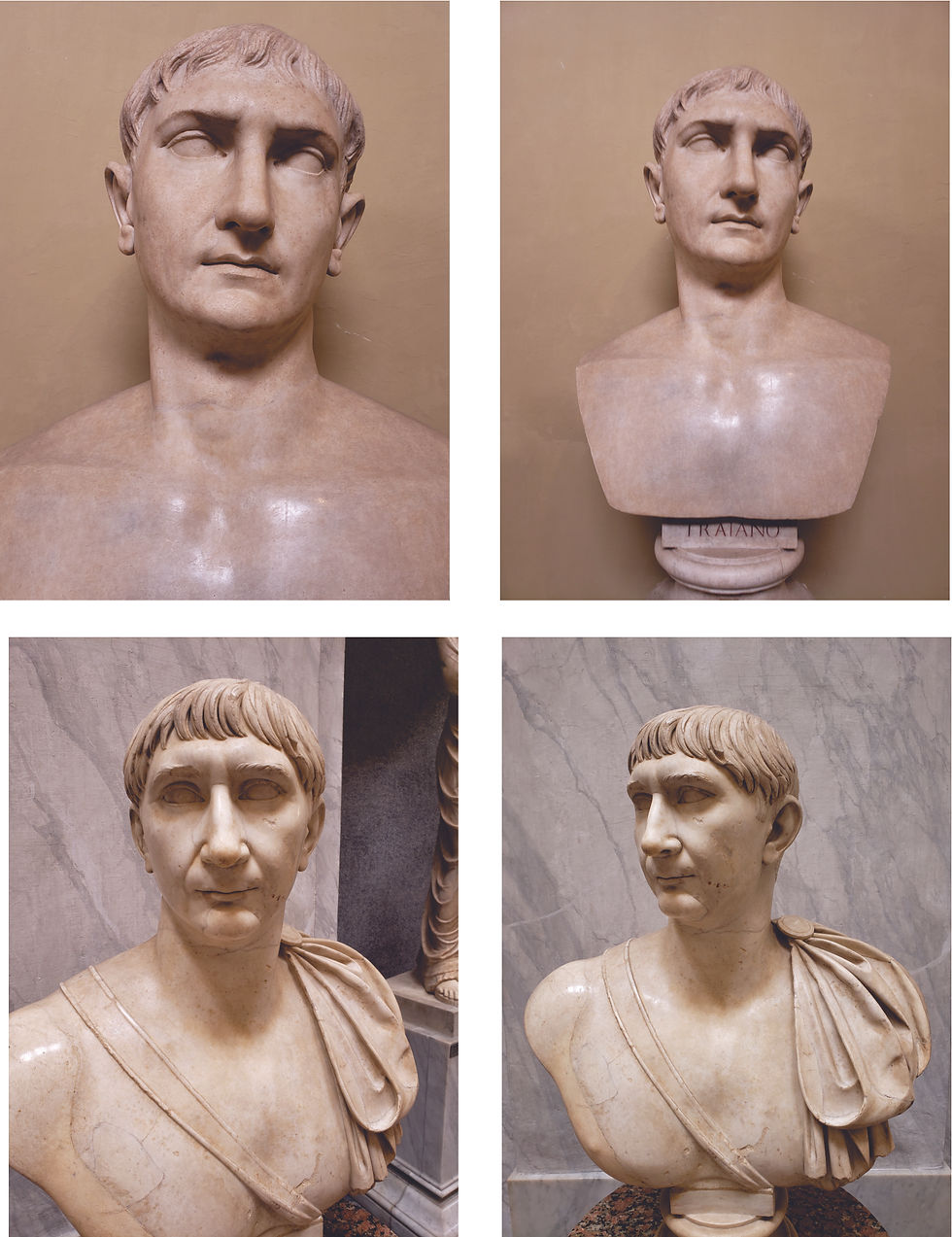I love a great bust!
- mrtomlukens
- Sep 25, 2021
- 7 min read
Updated: Sep 26, 2021
Something about the artform has always appealed to me. I actually own a few...I have an old bronze bust of Mao Zedong that I bought 20 years ago in Shenzhen. I have a pair of ceramic busts of Napoleon and Josephine and I have a gorgeous Alexander the Great, based upon the one from the Louvre, which appears here below. (the real one...not my fake!) I particularly love ancient Roman 'portrait sculpture'. These functioned beyond just art or vanity pieces...They were true, un-idealized likenesses, critically important to the leaders they memorialized, because they were the only manner through which the 'led' in a republic could confirm the identity of the 'leader'. Here are some of my favorites, photographed during my visits to the Louvre' and the Vatican Museums...along with a few comments about each. Enjoy!

This is one of my absolute favorites. This is King Mithridates VI 'Eupator'. He was an ancient Greco-Hellenist king of a state known as Pontus (modern day, Southern Turkey). Anyone who has read about the Roman consul/Dictator, Sulla knows Eupator was one of the Roman Republic's most determined and formidable opponents. He and Sulla famously traded barbs during their campaigns, like Michael Jordan and Gary Payton...but Sulla couldn't defeat him. Mithridates VI is maybe best known as the king who meticulously micro-dosed all kinds of poison in an attempt to render himself 'immune' to that type of assassination attempt. Pompey finally defeated Mithridates, but couldn't kill him either. In the final analysis, Mithridates was backed into a corner...tried to commit suicide with poison...AND IT WOULDN'T WORK, owing to his micro-dose poison diet. (Luckily a friend was there to help with a sword.) Cool guy. (note any bust with the subject wearing a lion's skin indicates that subject's self-association to the demi-god, Hercules.)

This is Alexander the Great of Macedonia. This magnificent piece is in the Louvre' and stands as the only Alexander piece confirmed to have been carved during his lifetime. As Alexander was only 32 when he died, its likely that this was made very close to the end of his life. The inscription on the front confirms the subject as: Alexander, son of Phillip II of Macedon. BTW: If you don't know much about Alexander, I think you'll love reading about him. I believe his life may one of the most remarkable lived in all of human history.

Speaking of 'remarkable lives', here's the other guy who best answers that calling for me. Gaius Julius Caesar has to be leader of a very short list of the most consequential lives ever lived...and one of my most favorite historical subjects. The Louvre' bust on the right is an at least 2x life sized bust, carved about 100 years after his life...like, during the reign of the second emperor, Tiberius. The one on the left is the only extant portrait-bust carved during his lifetime. I find this one interesting because its high cheekbones and neck lines appear in all the portraits on coins distributed during his life. I think this one must be very close to his actual likeness! (Its also interesting that multiple historical sources of Caesar's time confirm that on the day Caesar was murdered, his wife, Calpurnia begged him not to leave home, owing to a fateful dream she'd had the night before. She pulled at his toga and caused a bust of Caesar near the door, known as his favorite to fall and shatter. Damn! I'd like to have seen THAT one.)

Demosthenes was a great Athenian Orator, whose style of speaking influenced Cicero, Caesar and countless other original thinkers throughout antiquity. As a young man in about 450BC, Demosthenes won forever fame for his, "Phillipics". These were a series of fiery speeches denouncing the hold over Athens, by Phillip of Macedon. (the father of Alexander the Great) The Phillipics inspired Athens to stand up to Phillip and recover some level of autonomy. The best story about Demosthenes though: After his parents untimely death, when he was a young boy, Their wealth was transferred to another family, which began to spend away his birthright. As a 17 year old, he took the case to Athenian court and successfully sued for independence and the return of his family's doe. These are separate busts, BTW...The left is from the Vatican Museum, the right from the Louvre'. (Both my photographs) One must have been used at some point as a model for the other.

Here's a great one! These are two life-contemporary, portrait busts of the great Roman General Gaius Marius, who unprecedentedly held seven Roman consulships. Obviously the two upper photos are of a bust from his youth and the lower 2 from his older age. (Both are my photographs made at the Vatican.) Marius was a brilliant commander, who introduced most of the Roman warring tactics that revolutionized the age and made Rome a nearly unbeatable force for hundreds of years after his departure. I love seeing this progression, because it confirms the quality of roman portrait sculpture in arriving at an obviously pinpoint likeness. (I just love this stuff.)

This is a sad one for me. This young man whose bust stands at the Vatican is Marcus Marcellus, who was nephew of the first Roman Emperor, Augustus. His mother was Augustus' sister, Octavia, who is known by history for having lived a magnificent life in her own right. Marcellus was being preened as Augustus' heir to the emperorship, but died as a very young man after contracting a sort of ancient pandemic. (Augustus, himself recovered from the same, some months earlier.) The beautiful 'theater of Marcellus' was dedicated after his death...and still stands today, next to the Tiber. Let me know if you think Marcellus bears a more than slight resemblance to our son Jackson!

Here's another young/old progression. These two busts are of the Roman Emperor Trajan. I photographed both on display at the Vatican museum. Trajan oversaw the Roman empire during its largest and wealthiest period from about 100AD to about 117, when Hadrian ascended. I guess Trajan is best known for WILDLY increasing Rome's wealth, by sacking the gold-rich state of Dacia. (modern-day, Western Romania) He used a significant portion of this bootie to design and build 'Trajan's forum', which lies in spectacular ruin today in modern Rome. His still-standing, 'Trajan's Column' features a winding cartoon relief that tells the story of his daylight mugging of Dacia and other great gifts he made to Rome.
Hands down though...Trajan's got the goofiest hairdo of all antiquity...am I right?!

These are all busts of the Roman emperor, Hadrian. The upper left is from the Louvre' and the others are from the Vatican Museum. All are my photographs. There must be more extant busts of Hardrian than all the other emperors combined. Both the Louvre' and Vatican museums are also FULL of likenesses of his great lover and companion, 'Antinos'. Hadrian is perhaps best known for having exhaustively toured ALL of Rome's provinces during his reign...then for building sections to 'Hadrian's Villa' outside of Rome, honoring each great state he'd toured. Antinos died tragically, while touring Egypt and the Nile with Hadrian on a 'great golden barge'. He slipped into the river and drowned as Hadrian watched in horror. Ancient historians report that he 'wept and remained despondent' over the loss of Antinos for the balance of his life.

Here is the lesser-known Roman Emperor, 'Licinius' from about 300AD. This guy was an imperial colleague of the emperor Constantine, who moved the seat of Roman power from Rome to Constantinople (modern-day, Istanbul) Licinius is best known for his support for the 'Edict of Milan' which granted Rome's first official 'toleration of Christianity'. I like this bust because it uses what became a go-to, for ancient artists depicting christians: A sort of Jesus-smitten glaze carved into the eyes, as you can see here. The most famous bust of Constantine does this too, and makes him look like a goofy, kool-aid sipping drone.

How cool is THIS one? This is Perikles, the great Athenian warrior/leader from the height of Athenian power, about 450BC. Perikles is best known for building the Acropolis and Parthenon and other great Athenian works after his great victories in the Peloponnesian wars. History knows him as a great and fair leader, who advanced intellectual and educational pursuits and made his Athens the ancient world's educational center...some refer to Athens' golden age as the, "age of Perikles". See if you can find any other bust of this man, which doesn't include a hoplite helmet tilted backward as this one features! Apparently, Perikles had one of those difficult births that leaves the child's head oddly elongated...and he remained self conscious about being a banana head, his entire life.

Here is another one from the Louvre'. This is Marcus Agrippa...a magnificent General and engineer from the late Republic and early Empire. When Caesar was assassinated, he'd been preparing for a campaign against Parthia, to avenge the earlier death there of his co-triumvir, Marcus Crassus. Armies had already deployed to the area the attack was to be launched from...and this included 'Octavian', Caesar's great nephew, who later became known as the first emperor, Augustus. Agrippa met and befriended Octavian as their armies waited for Caesar to join and launch the attack. (...Which of course, never happened.) The friendship of Ocatvian and Agrippa, begun when each were teenagers, became a legendary co-op that ended the Roman Empire and cemented the 'Principate' (actually Empire) that replaced it. Agrippa is 100% responsible for every great military victory that centralized Augustus' legendary powers and elevated him as the unquestioned 'first citizen' of Rome.

Here's Marcus Tullius Cicero! The top piece is from the Vatican, the bottom, from the Louvre'. Cicero was the greatest Orator and advocate from late Republican Rome. It is the extant catalogue of letters between Cicero and his old Friend Atticus (living in Athens) that gives us our clearest view of late Roman Republic politics. Cicero was directly involved in EVERY important event that resulted in the dissolution of the Roman Republic and the advent of the Roman Empire...and he discussed each with Atticus. He supported Pompey's Republican army, after Caesar crossed his Rubicon and marched on Rome...and Cicero begged Pompey (the great General and current Consul), along with Cato to stay in Rome and face Caesar's legions, but then fled with Pompey, et al to Greece before Caesar arrived. After Caesar's victory against Pompey and his murder, Cicero wrote a series of 'Phillipics' against Mark Antony, who had become a defacto, triumvirate leader of Rome (along with Octavian and Lepidus) that so angered Antony that he hunted and killed Cicero. The great orator's head and hands ended up decorating the Roman forum's speaking platform...with a knitting needle pierced through the tongue, which had so offended Antony.
I guess Cicero is a great place to stop...I hope some of my love of Roman history interests you as well. My obsession began while we lived in Hong Kong and I started to read the historical novels of Cathleen McCollough, then leap'd to hardcore history texts of all eras of Roman history. I had a 3 hours per day commute from home to office and back in those days and I read more than during any period of my life.
Vale, citizen!





Comments